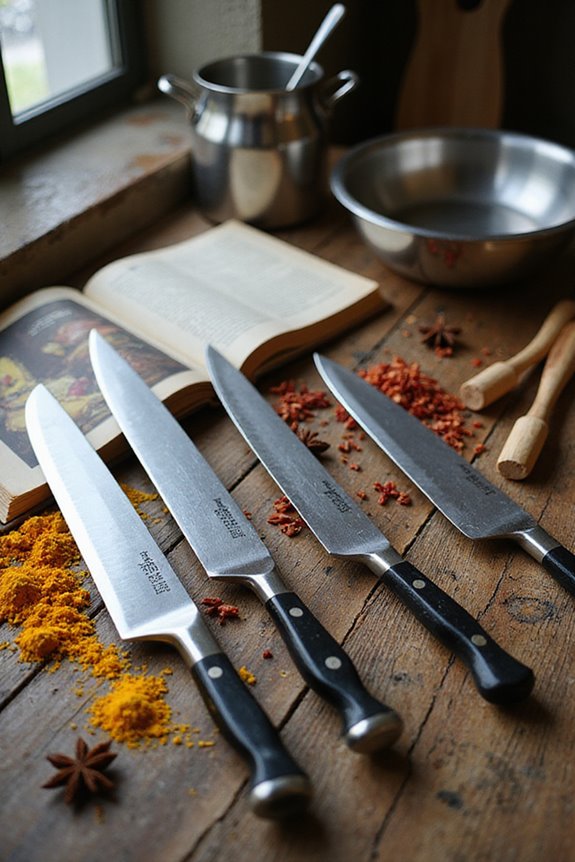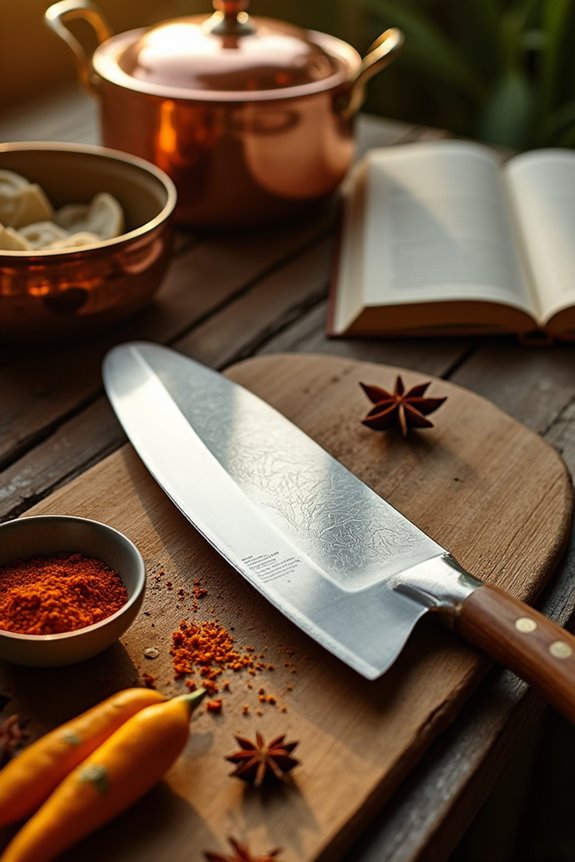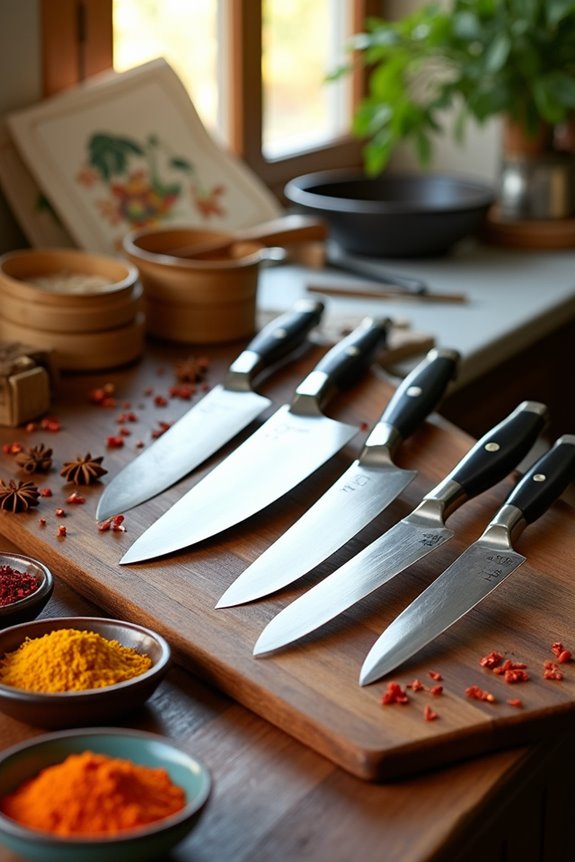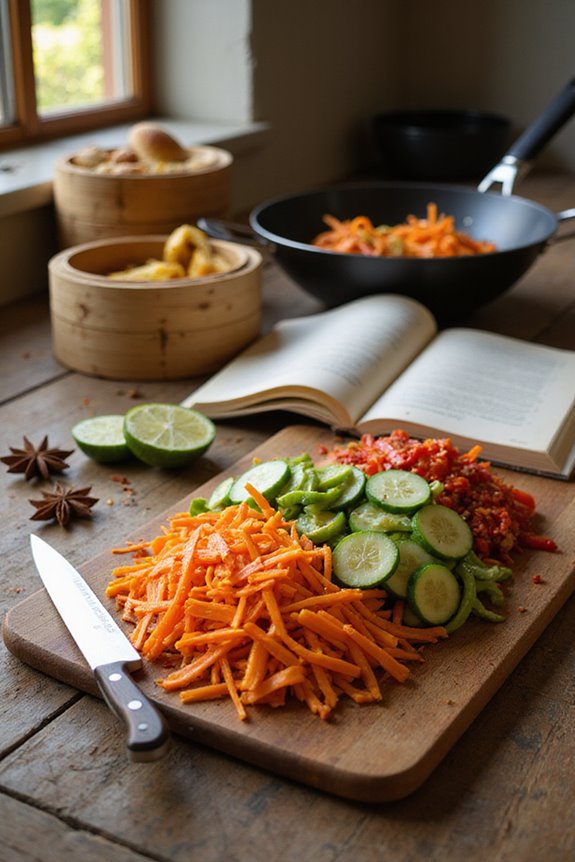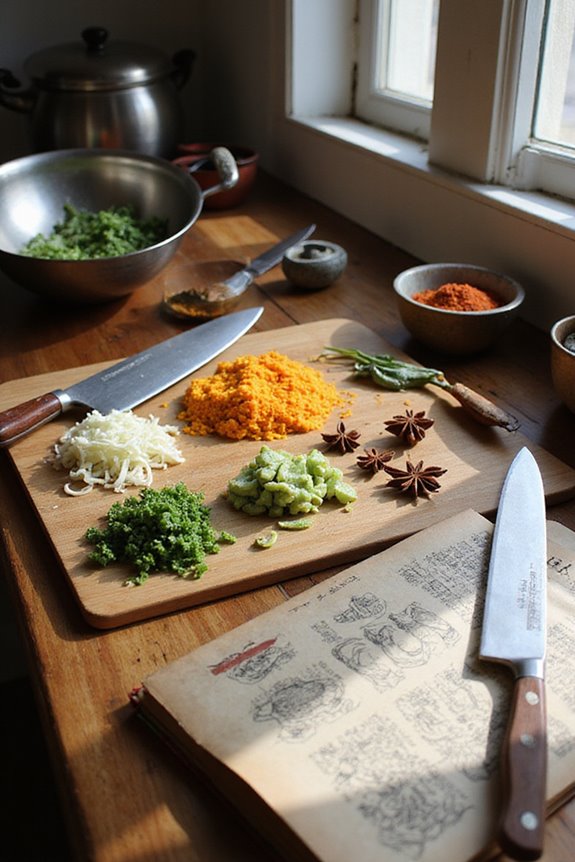Japanese knives come in delightful varieties, each with its own magical purpose. We’ve got chef’s knives like Gyuto and Santoku for all-around goodness, while vegetable knives such as Nakiri and Usuba are perfect for those precise cuts. Don’t forget about fish knives like Deba and Yanagiba for sushi dreams, and boning knives like Honesuki for effortlessly tackling meats. By exploring their unique features, we can discover the perfect fit for our cooking style. Stay tuned for more exciting tips!
Key Takeaways
- Chef’s and All-Purpose Knives include Gyuto for meat and fish, and Santoku for versatile slicing and chopping tasks.
- Vegetable Knives like Nakiri feature a straight blade for precision, while Usuba offers traditional cuts with an ergonomic design.
- Fish and Slicing Knives include Deba for butchering fish and Yanagiba for sashimi, emphasizing sharpness and technique.
- Boning and Utility Knives such as Honesuki have triangular blades for precision boning and versatile functionality.
- Specialty and Regional Variants showcase unique craftsmanship, with notable styles from Sakai, Sanjo, and Tosa, reflecting cultural heritage.
Chef’s and All-Purpose Knives
When it comes to the delightful world of cooking, choosing the right knife can feel like unwrapping a gift during the holidays! Let’s explore two amazing options: the Gyuto and Santoku.
- Gyuto Advantages: This Japanese chef’s knife shines with its long, slender blade, perfect for everything from meat to fish. Its lightweight design makes it easy on our wrists.
- Santoku Versatility: Known for its “three virtues,” this knife is our everyday hero for slicing, dicing, and chopping. Its wide blade makes food transfer effortless and its compact size fits right into our hands!
Both knives bring magic to meal prep, and using tools made from high-quality materials can enhance their effectiveness. So, whether we’re flipping pancakes or prepping dinner, let’s celebrate cooking with the best tools in our kitchen!
Vegetable Knives
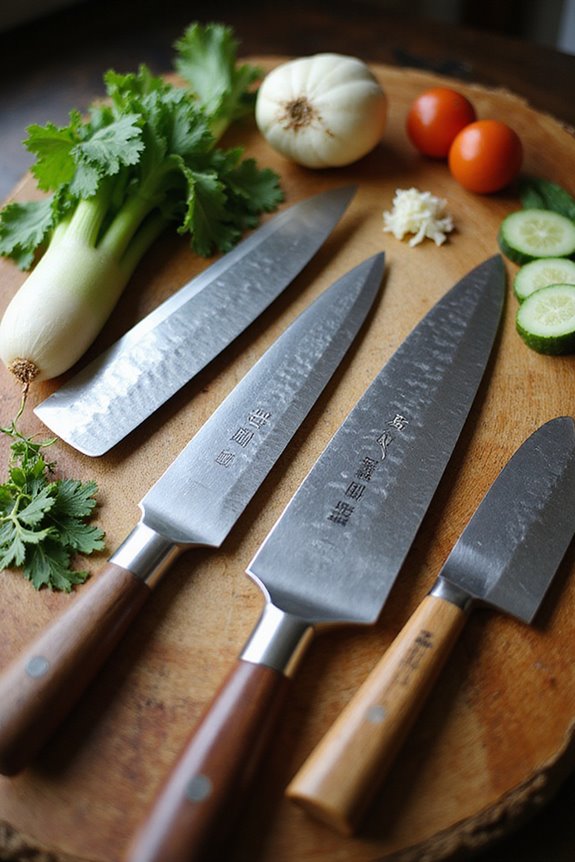
Vegetable knives are truly a chef’s best friend in the kitchen, making vegetable prep a delightful breeze! For those of us who love cooking, the Nakiri boasts a straight, rectangular blade perfect for precise cuts. With a double-bevel edge and typically measuring between 165 to 180 mm, it’s incredibly versatile. On the other hand, let’s not overlook the Usuba! This specialty knife features a single bevel, ideal for that magical, traditional Japanese touch.
Here’s how we love using them:
- Chopping & Slicing: Perfect for julienne, brunoise, and dicing.
- Fruit & Veggie Friendly: Works well on all types of vegetables!
Ready to take our vegetable cutting to the next level? Grab a Nakiri or Usuba, and let’s slice away! Additionally, ergonomic designs in Japanese knives enhance comfort during use, making these tools not just beautiful but also functional.
Fish and Slicing Knives
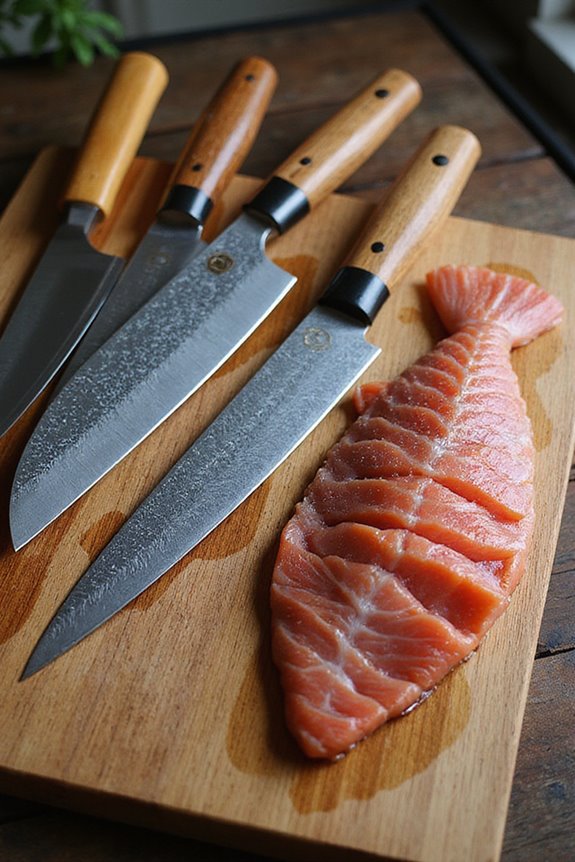
After mastering those vibrant vegetable cuts, it’s time to explore the magical world of fish and slicing knives! These tools are essential for fish preparation techniques, allowing us to create delightful dishes. Let’s immerse ourselves in some key types:
- Deba Knives: Great for butchering fish with their thick, sturdy blades.
- Yanagiba Knives: Long and sharp, perfect for slicing raw fish for sushi.
- Takohiki Knives: Similar to Yanagiba but with a unique square tip. Additionally, understanding the importance of regular maintenance ensures your knives remain sharp and effective for all your culinary needs.
Boning and Utility Knives
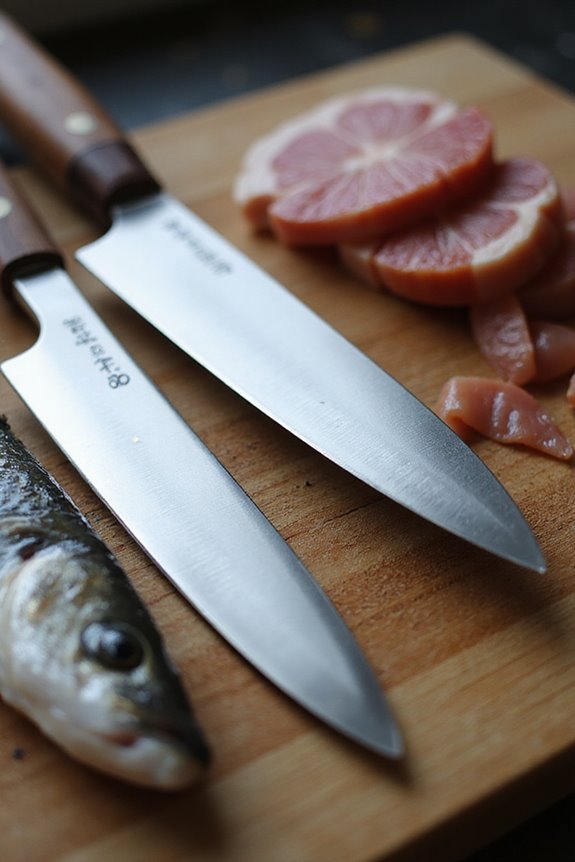
Boning and utility knives can truly transform our kitchen experience, especially when tackling poultry and meat prep! These honesuki knives are our secret weapon, sporting a triangular blade that allows for precise cuts and stunning boning techniques. With their stiff design, they offer fantastic knife versatility—perfect for everything from deboning to trimming larger cuts.
Here’s the deal:
- They excel at cutting through cartilage and soft joints.
- High-carbon steel variants keep their edge longer.
- Stainless steel models save us the hassle of constant maintenance.
- Premium knife sets often include specialized knives like honesuki for precise culinary tasks.
Specialty and Regional Variants
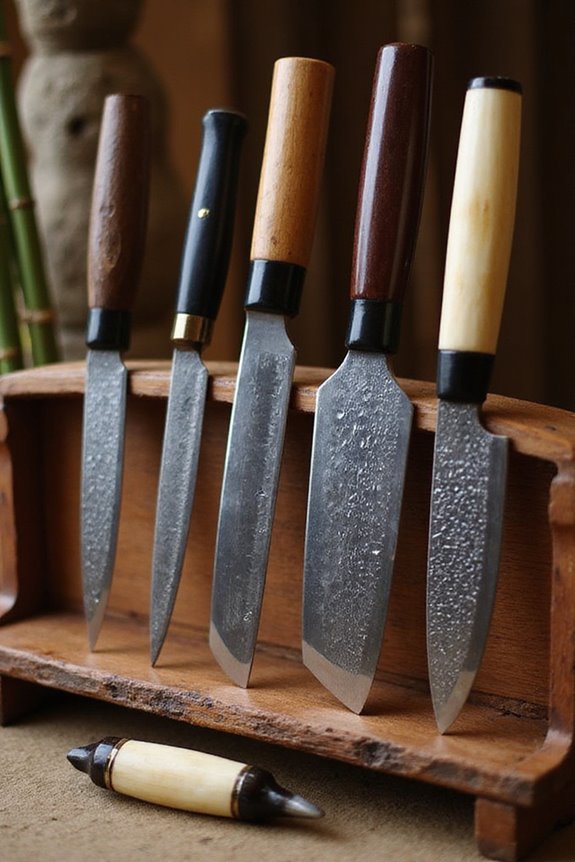
When we plunge into the world of specialty and regional knife variants, it feels like unwrapping a delightful present during the holidays! Each region in Japan brings its own magical touch to knife-making, showcasing unique regional knife features. For instance, Sakai’s renowned sashimi and deba knives symbolize the essence of Japanese cuisine, while Sanjo blends traditional with modern for durable Western-style knives. Tosa’s black forged Kurouchi knives highlight a rustic charm perfect for heavy-duty slicing.
When exploring these specialty knife origins, remember each knife tells a story of craftsmanship and culture. Furthermore, investing in authentic recipes can enhance your experience and appreciation of the culinary skills these knives help you master. So, whether you’re slicing sashimi or chopping veggies, there’s a perfect regional knife waiting for you. Let’s celebrate the artistry and utility of these delightful tools!
Blade Characteristics and Edge Styles
Exploring the blade characteristics and edge styles of Japanese knives is like venturing into a magical kitchen wonderland! These incredible tools often feature high-carbon steel cores, giving us exceptional sharpness and edge durability:
- Blade Materials: Whether it’s Damascus or Honyaki, each offers its unique magic!
- Edge Styles: Most knives like Gyuto and Santoku sport double bevel edges, making them versatile heroes in our culinary adventures.
The thinner, lighter blade geometry allows for precision cutting, helping us create delightful dishes without fuss. Plus, keep in mind, maintaining these thin edges is essential, as they can chip more easily than their Western counterparts. Embrace the journey with your Japanese knife, and watch your kitchen turn into a festive feast! 🎉👩🍳 Additionally, understanding the importance of material selection can greatly enhance the durability and performance of your knives, ensuring they elevate your cooking experience.
Choosing the Right Knife for Your Cooking Style
Have you ever wondered how to choose the perfect Japanese knife for your cooking adventures? It is understood it can feel overwhelming, but let’s break it down with some fun knife selection tips.
- Gyuto: Perfect for rock-chopping—ideal for everything from onions to big proteins!
- Santoku: A delightful all-rounder, perfect for a home kitchen and smaller cuts.
- Nakiri: Magical for veggies, offering precision cuts that’ll impress anyone.
- Honesuki: The pro for deboning poultry—it’s a holiday must for those big dinners!
- Yanagi: Perfect for slicing fish like sushi, so you’ll be a culinary star.
With these cooking style considerations, we can find the right knife that makes our culinary creativity shine! Happy chopping!
Maintenance and Care for Japanese Knives
Caring for our Japanese knives is just as important as choosing the right one! To keep them magical, let’s use the best cleaning techniques. Always hand wash with warm water and mild detergent after every culinary adventure. Remember, never soak them — they’re no good at swimming!
For sharpening methods, a whetstone is our best friend. Regularly honing with ceramic or steel rods keeps that delightful edge sharp. We should also protect those precious blades with food-grade mineral oil to prevent rust.
Finally, storing knives responsibly is key! Use magnetic strips or proper blocks to keep them safe and sound. By following these tips, our knives will shine bright in our kitchens for years to come!
Popular Brands and Artisan Makers of Japanese Knives
When it comes to the magical world of Japanese knives, knowing the right brands and artisan makers can make all the difference in our cooking adventures! Here are some of our favorites:
- Misono: Renowned for quality, with a strong heritage in Seki City.
- Sakai Takayuki: Celebrated for hand-sharpened blades that embody centuries of artisan craftsmanship.
- Masamoto: A prestigious brand using ancient sword-making techniques.
- Yoshihiro: Offers diverse designs rooted in a century of craftsmanship.
- Miyabi: Blends German engineering with traditional Japanese knife heritage.
Exploring these brands allows us to appreciate their rich histories while choosing knives that inspire us in the kitchen. Let’s embrace the joy of cooking with these exquisite tools!
Frequently Asked Questions
How Do Japanese Knives Compare to Western Knives?
When we compare Japanese knives to Western ones, we see distinctive blade designs and cutting techniques. Japanese knives offer precision with thinner blades, while Western knives focus on durability for diverse culinary tasks.
What Is the Best Way to Sharpen Japanese Knives?
As we hone our skills, much like craftsmen shaping a blade, we employ precise sharpening techniques and gentle honing tools to renew our Japanese knives, nurturing their strength and beauty, ensuring they serve us faithfully.
Are Japanese Knives Suitable for Left-Handed Users?
Are Japanese knives suitable for left-handed users? Absolutely! We’ll find left-handed designs that feature ergonomic features, ensuring comfort and efficiency in the kitchen. Embracing these options enhances our cooking experience, together celebrating every unique culinary journey.
How Do I Choose a Knife Based on My Cooking Style?
When we choose a knife, we’re not just selecting a tool; we’re embracing a culinary companion. Our cooking techniques and knife preferences should align, enhancing our joy in the kitchen while showcasing our unique styles.
What Materials Are Best for Japanese Knife Handles?
When we consider materials for Japanese knife handles, wood offers traditional warmth and comfort, while resin provides durability and moisture resistance. We must balance handle ergonomics to enhance our cooking experiences and connect with culinary traditions.

